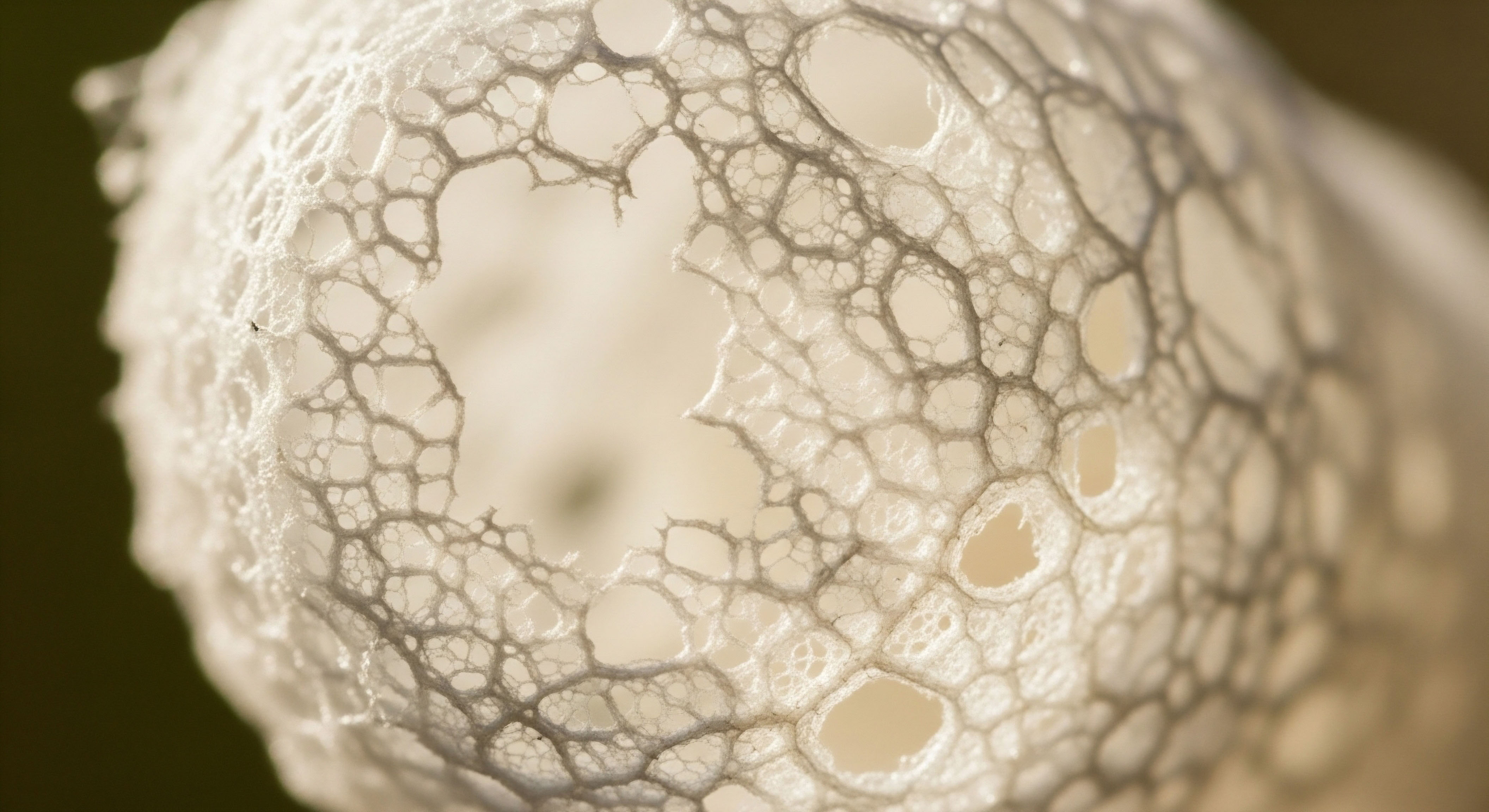

Fundamentals
You might notice subtle shifts in your vitality, perhaps a quiet diminution of that youthful resilience you once possessed. This feeling, often dismissed as an inevitable aspect of aging, frequently points to deeper physiological recalibrations occurring within your biological systems. A crucial, yet often overlooked, indicator of overall well-being resides in the suppleness of your arteries.
Arterial elasticity, the ability of these vital conduits to expand and contract with each heartbeat, represents a fundamental marker of cardiovascular health and, indeed, biological age.
Consider your arterial system as an intricate network of sophisticated pipelines. Their optimal function relies on their inherent flexibility, allowing them to efficiently distribute blood and nutrients throughout your body. When this elasticity diminishes, arteries stiffen, demanding more effort from the heart and potentially impacting the perfusion of every organ. Understanding this intrinsic biological process becomes the first step toward reclaiming optimal function.
The pliability of your arteries offers a silent, yet profound, insight into your body’s overall state of health.

Understanding Arterial Rigidity
Arterial rigidity, often measured as pulse wave velocity, reflects changes in the structural integrity of the arterial wall. This phenomenon arises from alterations in the extracellular matrix, the complex scaffold providing structural support to cells. The two primary components dictating arterial elasticity are collagen and elastin. Collagen provides tensile strength, while elastin confers stretch and recoil properties. An imbalance in their synthesis and degradation, or excessive cross-linking of collagen fibers, contributes to a less compliant vascular system.
The body possesses an extraordinary capacity for self-regulation and repair. Hormonal messengers orchestrate many of these restorative processes. These biochemical signals, circulating throughout your system, communicate instructions to cells and tissues, influencing everything from metabolic rate to tissue regeneration.

The Body’s Internal Regulators
Endocrine glands release hormones, acting as the body’s internal messaging service. These chemical communicators transmit vital instructions, influencing metabolic function, cellular growth, and tissue repair. A balanced endocrine system maintains physiological equilibrium, contributing significantly to sustained vitality. When these systems operate harmoniously, they support the integrity of structures like your arterial walls, ensuring their capacity to adapt to physiological demands. Your daily choices exert a profound influence on the efficiency and clarity of these internal communications.


Intermediate
For individuals already familiar with foundational biological concepts, the exploration deepens into how deliberate lifestyle choices interact with targeted biochemical interventions to support arterial health. Your daily rhythms, from the food you consume to the quality of your sleep, act as powerful modulators of your internal environment. These external inputs directly influence the cellular machinery responsible for maintaining vascular integrity.

How Lifestyle Influences Vascular Health?
A structured approach to daily living profoundly impacts the dynamic equilibrium of your cardiovascular system. Dietary patterns, for instance, contribute essential building blocks and anti-inflammatory compounds, which protect endothelial cells and support healthy extracellular matrix turnover. Regular, varied physical movement enhances endothelial function and stimulates nitric oxide production, promoting vascular relaxation and reducing arterial stiffness.
Restorative sleep cycles are essential for hormonal regulation and cellular repair. During deep sleep, the body undergoes critical restorative processes, including the optimal release of growth hormone, a key player in tissue maintenance. Chronic stress, conversely, triggers sustained cortisol elevation, which can detrimentally affect endothelial health and accelerate arterial stiffening over time. Mitigating these stressors becomes a fundamental aspect of preserving vascular compliance.
- Nutrient-Dense Diet ∞ Prioritize whole, unprocessed foods rich in antioxidants, omega-3 fatty acids, and fiber to combat oxidative stress and inflammation.
- Targeted Movement ∞ Combine aerobic exercise, which improves vascular tone, with resistance training, which supports overall metabolic health.
- Restorative Sleep Hygiene ∞ Aim for 7-9 hours of quality sleep nightly to optimize hormonal secretion and cellular repair mechanisms.
- Mindful Stress Management ∞ Incorporate practices like meditation or deep breathing to mitigate the detrimental effects of chronic psychological strain on your cardiovascular system.
Intentional lifestyle choices create a fertile internal landscape for optimal vascular function and cellular repair.

Peptide Therapies for Vascular Support
Peptide therapies represent a sophisticated approach to biochemical recalibration, working in concert with lifestyle adjustments. Growth hormone secretagogues (GHSs) are a class of peptides designed to stimulate the body’s natural production and pulsatile release of endogenous growth hormone. This stimulation, in turn, leads to an increase in insulin-like growth factor-1 (IGF-1), a powerful anabolic and regenerative hormone.
These peptides do not introduce exogenous growth hormone; rather, they encourage the pituitary gland to function more robustly, mimicking the body’s inherent physiological rhythms. By enhancing the somatotropic axis, these agents can contribute to improved collagen synthesis, reduced inflammation, and enhanced cellular repair throughout the body, including within the delicate structure of arterial walls. This targeted support aids in maintaining the structural integrity and functional elasticity of your vascular network.
| Factor | Mechanism of Action | Impact on Arterial Elasticity |
|---|---|---|
| Nutrient-Rich Diet | Provides antioxidants, reduces inflammation, supplies collagen precursors | Supports endothelial health, aids extracellular matrix repair |
| Regular Exercise | Enhances nitric oxide production, improves vascular tone, reduces blood pressure | Promotes vasodilation, reduces arterial stiffness |
| Growth Hormone Secretagogues | Stimulate endogenous GH/IGF-1 release from the pituitary gland | Increases collagen and elastin synthesis, supports tissue regeneration |
| Stress Reduction | Lowers cortisol, reduces sympathetic nervous system activation | Mitigates endothelial damage, preserves vascular compliance |


Academic
The profound impact of biological systems on arterial elasticity necessitates a deep exploration into the molecular and cellular underpinnings of vascular remodeling. The arterial wall represents a dynamic biomechanical structure, constantly adapting to hemodynamic forces. Its mechanical properties, particularly compliance, are predominantly determined by the integrity and organization of its extracellular matrix (ECM), a complex network of macromolecules synthesized and maintained by vascular smooth muscle cells and fibroblasts.

Molecular Mechanisms of Arterial Remodeling
The ECM of large arteries is characterized by a precise balance of collagen and elastin fibers. Elastin, with its unique cross-linked structure, confers resilience and allows for significant deformation and recoil, thereby dampening pulse pressure. Collagen, primarily types I and III, provides tensile strength and limits overstretching.
Arterial stiffening often correlates with an increase in collagen content, a reduction in functional elastin, and the formation of advanced glycation end-products (AGEs) that induce pathological cross-linking of ECM proteins. The delicate equilibrium between matrix metalloproteinases (MMPs), which degrade ECM components, and their tissue inhibitors (TIMPs) dictates the ongoing remodeling of the vascular wall. Imbalances in this system drive pathological stiffening.

The Somatotropic Axis and Vascular Integrity
The somatotropic axis, comprising growth hormone (GH) and insulin-like growth factor-1 (IGF-1), exerts pleiotropic effects on vascular biology. GH, secreted pulsatilely from the anterior pituitary, stimulates hepatic and local production of IGF-1. IGF-1, in turn, acts as a potent mitogen and anti-apoptotic factor for vascular smooth muscle cells and endothelial cells.
It also plays a pivotal role in fibroblast activation and the synthesis of ECM components. Studies indicate that optimal GH/IGF-1 signaling supports the production of healthy collagen and elastin, while dysregulation of this axis, such as in states of GH deficiency, often correlates with increased arterial stiffness.
Growth hormone secretagogues (GHSs), including Sermorelin, Ipamorelin, and CJC-1295, operate by binding to specific receptors on somatotrophs in the pituitary gland, thereby amplifying the natural pulsatile release of GH. Sermorelin, a GHRH analog, directly stimulates GH secretion.
Ipamorelin and CJC-1295 (a GHRH analog with a longer half-life) are GHRPs, which mimic ghrelin’s action to enhance GH release and also suppress somatostatin, a natural inhibitor of GH. This augmented physiological GH pulsatility translates into increased systemic and local IGF-1 levels. The downstream effects include enhanced transcription and translation of collagen type I and III, improved elastin fiber integrity, and a modulated MMP/TIMP balance, all contributing to a more favorable ECM composition within the arterial wall.
| Peptide | Primary Mechanism | Key Vascular Effects |
|---|---|---|
| Sermorelin | GHRH analog, direct pituitary stimulation | Increases GH pulsatility, supports collagen/elastin synthesis via IGF-1 |
| Ipamorelin | GHRP, selective GH secretagogue, no cortisol/prolactin increase | Enhances GH release, promotes tissue repair, potentially reduces inflammation |
| CJC-1295 | Modified GHRH analog, prolonged action via DAC | Sustained GH/IGF-1 elevation, aids long-term ECM remodeling |
| Tesamorelin | GHRH analog, specifically reduces visceral adipose tissue | Indirectly improves metabolic profile, which benefits endothelial function |

Synergistic Modulations of Endothelial Function?
The synergy between judicious lifestyle choices and targeted peptide therapies arises from their complementary actions on cellular and molecular pathways. Lifestyle interventions, such as a diet rich in polyphenols and regular exercise, directly enhance endothelial nitric oxide synthase (eNOS) activity, promoting vasodilation and reducing oxidative stress within the vascular endothelium.
These actions create a permissive environment for optimal cellular function. Simultaneously, GHS peptides provide a direct anabolic stimulus through the GH/IGF-1 axis, promoting the synthesis of healthy ECM components and facilitating cellular repair.
Consider the combined impact ∞ a well-nourished and physically active body exhibits reduced systemic inflammation and improved metabolic markers, which inherently protect the vascular endothelium. Within this optimized milieu, the enhanced GH/IGF-1 signaling, augmented by peptides, can more effectively drive the restorative processes necessary for maintaining arterial elasticity. This integrated approach, therefore, addresses both the environmental stressors and the intrinsic regenerative capacities of the vascular system, offering a comprehensive strategy for sustaining cardiovascular vitality.
- Hormonal Axis Optimization ∞ Lifestyle factors such as sleep and stress directly influence the HPG and somatotropic axes, while peptides offer a targeted means to amplify GH/IGF-1 signaling.
- Extracellular Matrix Support ∞ Nutrient availability from diet provides the building blocks, and GH/IGF-1 stimulation from peptides drives the synthesis of collagen and elastin.
- Inflammation and Oxidative Stress Mitigation ∞ Antioxidant-rich diets and exercise reduce systemic inflammation, creating a more favorable environment for peptide-mediated repair.
- Endothelial Cell Function ∞ Lifestyle choices enhance eNOS activity, and improved hormonal balance supports endothelial integrity and responsiveness.
Integrating lifestyle with peptide therapy creates a powerful, multi-modal strategy for optimizing arterial health at a cellular level.

References
- Fleg, Jerome L. et al. “Arterial Stiffness ∞ A New Cardiovascular Risk Factor.” American Heart Journal, vol. 154, no. 3, 2007, pp. 433-438.
- Lakatta, Edward G. and Daniel Levy. “Arterial and Cardiac Aging ∞ Major Shareholders in Cardiovascular Disease Enterprises.” Circulation, vol. 107, no. 3, 2003, pp. 346-354.
- Blackburn, G. L. et al. “A Placebo-Controlled, Double-Blind, Randomized Trial of Tesamorelin in HIV-Associated Lipodystrophy.” Clinical Infectious Diseases, vol. 54, no. 10, 2012, pp. 1478-1488.
- Vasan, Ramachandran S. et al. “Impact of High-Normal Blood Pressure on the Risk of Cardiovascular Disease.” New England Journal of Medicine, vol. 345, no. 18, 2001, pp. 1291-1297.
- Savastano, Silvia, et al. “Growth Hormone Deficiency and Cardiovascular Risk.” Journal of Clinical Endocrinology & Metabolism, vol. 96, no. 10, 2011, pp. 3020-3029.
- Isgaard, Jörgen, et al. “Growth Hormone and the Cardiovascular System.” Growth Hormone & IGF Research, vol. 12, no. 5, 2002, pp. 345-351.
- Sowers, James R. “Obesity, Hypertension, and Cardiovascular Disease ∞ An Update.” Hypertension, vol. 49, no. 4, 2007, pp. 748-752.
- Ungvari, Zoltán, et al. “Aging, Endothelial Dysfunction, and Arterial Stiffness ∞ A Comprehensive Review.” Journal of the American Heart Association, vol. 5, no. 10, 2016, pp. e003986.

Reflection
This journey into the intricate world of hormonal health and arterial elasticity offers a profound invitation for introspection. The scientific insights shared serve as a compass, guiding you toward a deeper understanding of your own biological systems. Recognize that this knowledge represents the initial stride in a personalized path toward reclaiming vitality and function.
Your unique physiology warrants a tailored approach, demanding thoughtful consideration and expert guidance. Consider this exploration a testament to the body’s remarkable capacity for adaptation and repair, waiting for your informed engagement to unlock its full potential.



